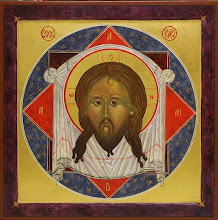
Sunday, June 21, 2009
The Holy Face, also known as Mandylion

St. James the Greater

Sunday, March 30, 2008
Mother of God of Tenderness

This is the icon I wrote for my granddaughter, Elizabeth, who is being married on April 5, 2008. It is one of the traditional icons that is considered suitable for a wedding gift. It was written in egg tempera using natural pigments and 24 karat gold on a gessoed wood board. The board has a depression in which the icon is written known as a kovcheg or ark. It is the container of the presence of the venerated Mother of God and Child. It has braces in the back to keep it from curving over time. It is 11" x 14". As you can see, I did inscribe a design onto the gold haloes.
Saturday, September 29, 2007
Simeon the God-Receiver

This icon is also known as, Simeon with the Christ Child. The story is told of the Presentation of Jesus in the Temple in the Gospel of Luke 2:25 - 32. We read that Simeon had been assured he would not die before he had seen the promised Messiah. When Mary and Joseph brought Jesus to the Temple after 40 days from his birth, as required by law, Simeon took Jesus in his arms and said, "Lord, now lettest thou thy servant depart in peace, according to thy word. For mine eyes have seen thy salvation, which thou hast prepared before the face of all people, to be a light to lighten the Gentiles, and to be the glory of thy people, Israel." These words have become part of Vespers in the Eastern church and Evening Prayer in the Western church. Simeon further prophesies in Luke 2:33 - 35, the future of Jesus and that a sword would pierce the heart of Mary.
The icon is 7" x 9" and written in egg tempera and gold on gessoed wood panel.
Saturday, September 15, 2007
The Virgin with the Playing Child
 There are many different icons of the Theotokos, also known as Mother of God, but, they generally fall into two categories or types. This icon is an Eleousa type, sometimes called Virgin of Tenderness or Virgin of Mercy.
There are many different icons of the Theotokos, also known as Mother of God, but, they generally fall into two categories or types. This icon is an Eleousa type, sometimes called Virgin of Tenderness or Virgin of Mercy. The Virgin with the Playing Child, is considered a variation of the Eleousa type and is also known by the name, Pelagonitissa, which refers to Pelagonia, a city in Macedonia, where it originated. Not only do we see the foreboding in the face of the Virgin with respect to her Child's eventual Passion, but, rather than thinking of the Child as playing, there are those who see the child as also being uneasy about his future.
In future postings, I will show more traditional icons of the Eleousa type as well as the other category of icons of the Theotokos , known as the Hodegitria, or She who Shows the Way. This icon is 7" x 9" and written in egg tempera and gold on gessoed wood panel.
Monday, September 10, 2007
Guardian Angel
 righteous are in the hands of God". This text is from Wisdom of Solomon 3:1. The icon is 13" x 17" and written in egg tempera and gold on a gessoed wood board.
righteous are in the hands of God". This text is from Wisdom of Solomon 3:1. The icon is 13" x 17" and written in egg tempera and gold on a gessoed wood board.
Saturday, September 8, 2007
This icon is called "Face Made without Hands", sometimes just, "Not Made by Hands", or The Holy Face, or even the Greek word for cloth, "Mandylion". The story was told that King Abgar of Edessa, being ill, sent a servant, the Court painter, to request that Jesus come and heal him. When Jesus was unable to do so, the painter proceeded to attempt to paint Jesus. When Jesus saw this, he washed his face and then pressed a cloth to his own face, leaving his image upon it, and gave it to him to take back to King Abgar. He was healed by this miraculous cloth. We know of the existence of the cloth as late as 944, when the sacred cloth was moved from Edessa to Constantinople.
